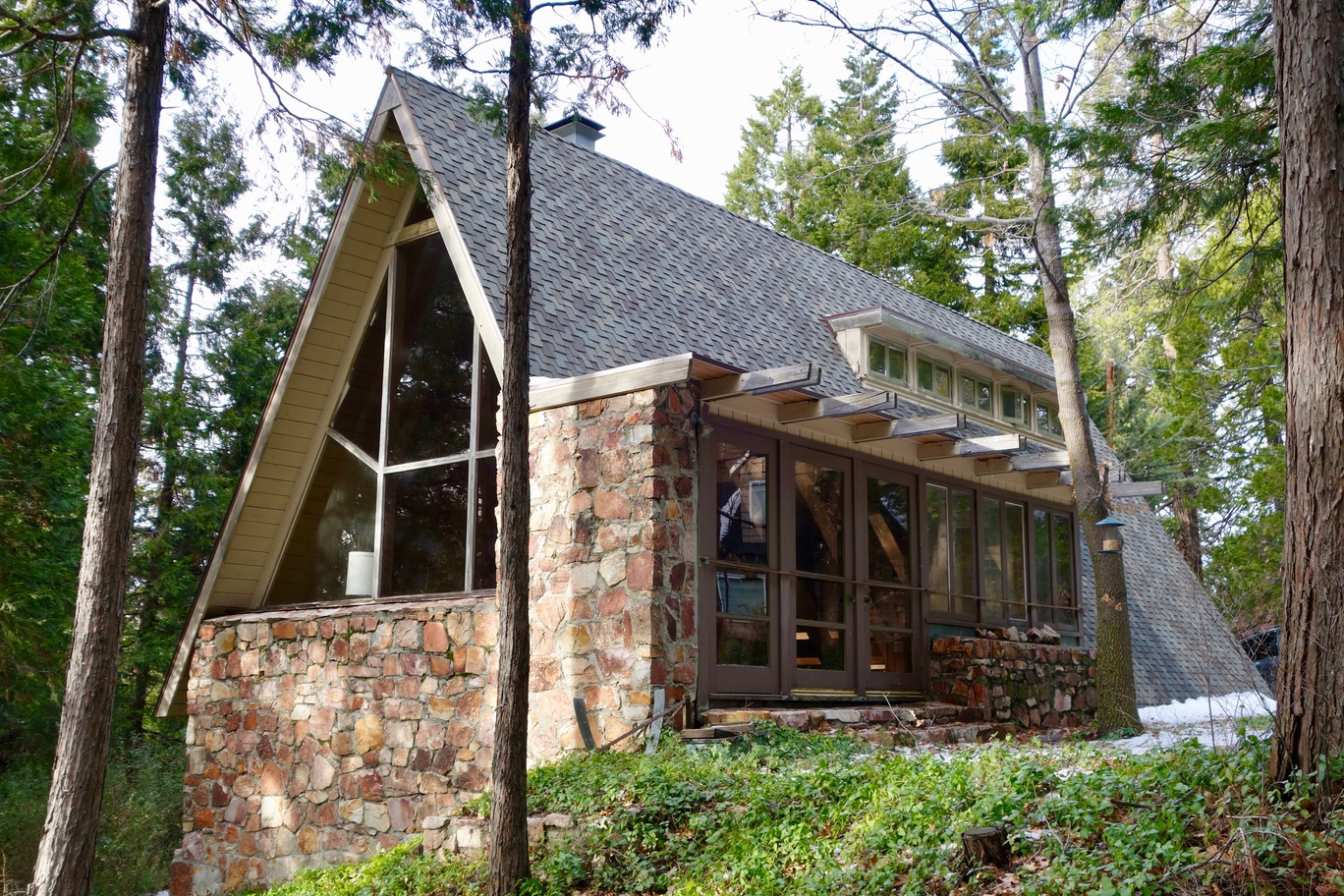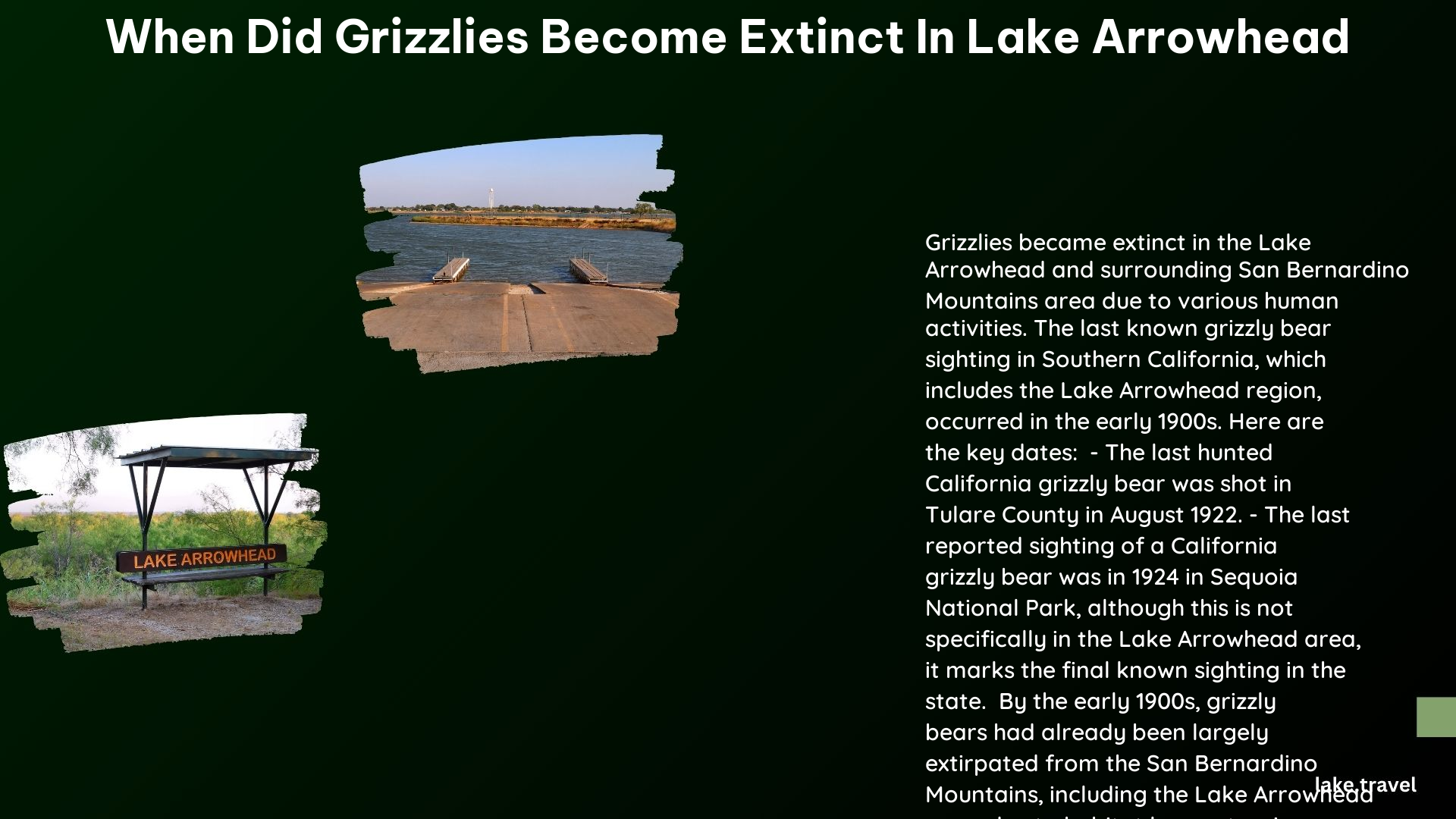The California grizzly bear, once prevalent throughout the state, vanished from Lake Arrowhead and surrounding areas in the early 20th century. While specific data for Lake Arrowhead is scarce, the last confirmed sighting of a California grizzly bear occurred in 1924 in Sequoia National Park. This extinction was part of a broader decline across California, driven by human expansion, hunting, and habitat loss. Lake Arrowhead, nestled in the San Bernardino Mountains, likely saw its grizzly population dwindle alongside the rest of the state.
What Was the Timeline of Grizzly Extinction in California?

The extinction of grizzlies in Lake Arrowhead was part of a larger statewide trend:
- Pre-1800s: Estimated 10,000 grizzlies in California
- 1848: Gold Rush begins, accelerating human-bear conflicts
- Late 1800s: Widespread hunting and habitat destruction
- 1908: Last grizzly killed in Southern California (Ventura County)
- 1922: Last hunted grizzly in California (Tulare County)
- 1924: Final confirmed sighting in Sequoia National Park
While no specific date is recorded for Lake Arrowhead, it’s likely the local grizzly population disappeared between 1908 and 1924.
Why Did Grizzlies Disappear from Lake Arrowhead?

Several factors contributed to the extinction of grizzlies in the Lake Arrowhead area:
- Human Settlement: As the region became more populated, human-bear conflicts increased.
- Habitat Loss: Deforestation and development reduced suitable bear habitats.
- Hunting: Both sport hunting and bounty hunting decimated bear populations.
- Livestock Protection: Ranchers often killed bears to protect their animals.
- Lack of Conservation Efforts: No significant protection measures were in place during this period.
What Was the Grizzly Population in Lake Arrowhead Before Extinction?
While exact numbers for Lake Arrowhead are not available, we can estimate based on broader California data:
- Pre-1800s: 10,000 grizzlies statewide
- 1850s: Approximately 1,000 remaining
- 1900s: Fewer than 100 statewide
Given Lake Arrowhead’s mountainous terrain, it likely supported a healthy grizzly population until the late 1800s, but numbers would have rapidly declined thereafter.
How Did Human Activities Impact Grizzly Habitats in Lake Arrowhead?
Human activities severely impacted grizzly habitats in and around Lake Arrowhead:
- Logging: Deforestation reduced bear habitats and food sources.
- Mining: The Gold Rush brought miners into bear territories.
- Agriculture: Conversion of land for farming reduced natural bear habitats.
- Urban Development: As Lake Arrowhead grew, bear habitats shrank.
- Recreation: Increased human presence in forests disturbed bear populations.
What Were the Last Recorded Sightings of Grizzlies Near Lake Arrowhead?
While specific sightings for Lake Arrowhead are not documented, nearby records provide context:
- 1908: Last grizzly killed in Southern California (Ventura County)
- 1922: Last hunted grizzly in California (Tulare County)
- 1924: Final confirmed sighting in Sequoia National Park
It’s likely that any grizzly sightings in Lake Arrowhead would have occurred before these dates, possibly in the early 1900s.
How Did Hunting Practices Affect Grizzly Populations in the Area?
Hunting played a significant role in the decline of grizzlies around Lake Arrowhead:
- Sport Hunting: Grizzlies were prized trophies for hunters.
- Bounty Hunting: Government bounties encouraged widespread killing of bears.
- Livestock Protection: Ranchers often shot bears to protect their animals.
- Lack of Regulations: No hunting limits or protected seasons existed for grizzlies.
- Advanced Weaponry: Improved firearms made bear hunting more efficient.
What Conservation Efforts, If Any, Were Made to Protect Grizzlies in Lake Arrowhead?
Unfortunately, conservation efforts came too late for Lake Arrowhead’s grizzlies:
- No significant protection measures were in place during the critical period of decline.
- California’s first wildlife protection laws weren’t enacted until the 1920s, after grizzlies were effectively extinct.
- The concept of endangered species protection didn’t exist during the grizzly’s decline.
- Local efforts, if any, were likely small-scale and undocumented.
How Has the Ecosystem Changed Since the Extinction of Grizzlies in Lake Arrowhead?
The extinction of grizzlies has had lasting impacts on the Lake Arrowhead ecosystem:
- Predator-Prey Balance: Removal of top predator altered wildlife populations.
- Vegetation Changes: Lack of grizzly foraging may have affected plant distribution.
- Scavenger Dynamics: Absence of grizzly carcasses impacted scavenger species.
- Human-Wildlife Interactions: Other species like black bears filled ecological niches.
- Nutrient Cycling: Grizzlies played a role in distributing nutrients across ecosystems.
What Lessons Can Be Learned from the Extinction of Grizzlies in Lake Arrowhead?
The extinction of grizzlies in Lake Arrowhead offers several important lessons:
- Importance of Early Conservation: Proactive measures are crucial for species protection.
- Human-Wildlife Coexistence: Balancing human needs with wildlife preservation is essential.
- Ecosystem Interconnectedness: The loss of one species can have far-reaching effects.
- Value of Historical Records: Documenting wildlife populations is crucial for future conservation efforts.
- Need for Habitat Preservation: Protecting natural habitats is key to species survival.
Are There Any Efforts to Reintroduce Grizzlies to Lake Arrowhead or Surrounding Areas?
Currently, there are no plans to reintroduce grizzlies to Lake Arrowhead or nearby areas:
- The California grizzly subspecies is extinct, making reintroduction impossible.
- Modern human population density makes grizzly reintroduction unfeasible.
- Focus has shifted to protecting existing wildlife and habitats in the region.
- Black bears now occupy much of the former grizzly habitat in the area.
- Conservation efforts concentrate on educating the public about local wildlife and habitat preservation.
References:
1. California grizzly bear (extinct) – Bear Conservation
2. The California grizzly bear | La Brea Tar Pits
